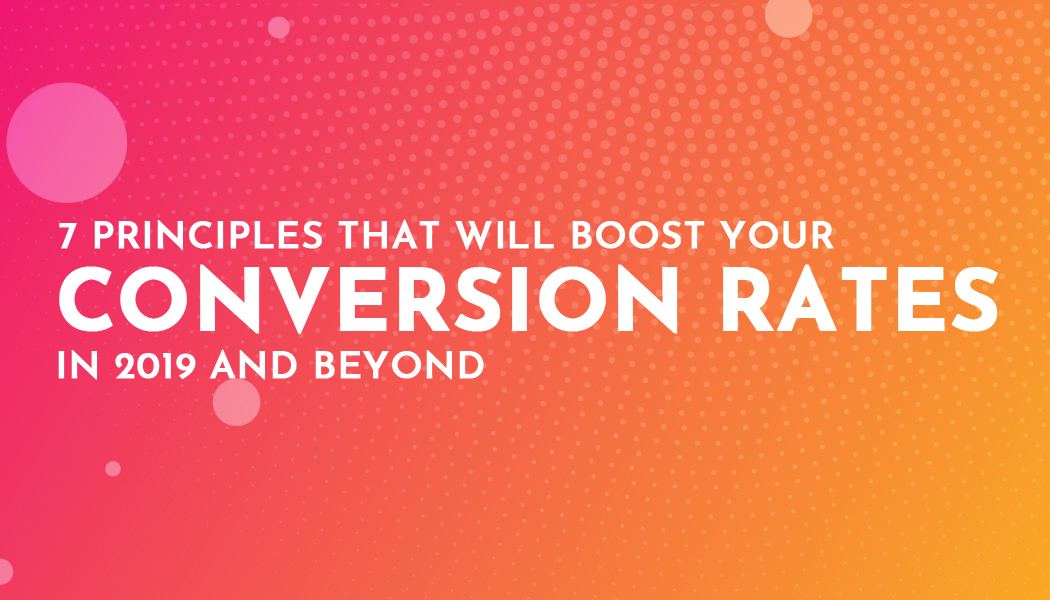7 Principles that Will Boost Your Conversion Rates in 2019 and Beyond
Who wouldn’t want to boost their conversion rates in 2019? As any decent marketer will tell you, your website design has a tremendous influence on your conversions. Of course, lead magnets, social media, and SEO are all valuable, but starting out with a well-designed website should be your first priority.
Smart web design is about so much more than vanity. It can make or break your dwell times and your conversion rates. In fact, a study published by Stanford University found that nearly half of consumers say that the design of a website is one of their top criteria for deciding if a company is reputable or not.
Most people would rather spend their time reading something that’s been beautifully designed than something boring or dull. In other words, if you want people to hang around and read your blogs, they need to be appealing to the eye. People will actually leave your site if it’s not attractive, and you will lose leads… and possible conversions.
So, even if design isn’t your strongest skill, it’s worth learning or hiring a pro to do it for you! Here are seven design principles that will boost your conversion rates in 2019 and beyond.
1. Image Quality
If there’s one thing that can turn website visitors off quickly, it’s poor quality images. Not only are consumers more likely to click on search results that include attractive images, but they are also more likely to contact businesses that showcase an image.
Steer clear of irrelevant, lifeless, dull stock images. Compelling images actually get 94% more views! Your images should be high-quality and relate to your content. They should have a personal feel because people like to buy from brands that they can relate to. Stuffy, sterile images will turn visitors off.

2. People are Attracted to Faces
Human faces trigger emotions. Include faces in your testimonials, opt-in pages, case studies, blog posts, and on landing pages to boost your conversion rates. Use professional, yet friendly photos of yourself and your staff. Or, include stock photos that include faces and relate to your brand and target demographic.
3. Get Familiar with Gestalt Design Principles

Gestalt design principles, especially the Similarity Principle, are essential to good website design. The basic concept behind the principles is that the human brain perceives the overall design of a page differently than it sees the individual components of the page.
The Similarity Principle explains that the human eye prefers to group similar objects together. When applied to web design, you should incorporate this principle by grouping items that you want to be associated with each other in the same area.
For example, if you have a great client testimonial that will help boost conversions on your opt-in form, place the testimonial right under the form. It doesn’t matter if the testimonial relates directly to your opt-in because the user will connect the two together since they are close to each other.
4. Remember the 8-Second Rule
Did you know that you only have eight seconds to grab your visitor’s attention when they land on your website? That’s the length of the human attention span. Since you only have such a tiny window, you’ve got to make sure those first few seconds count!
Here are some design principles that will grab your user’s attention in those precious eight seconds:
- Your headline should be large, to the point, and benefit-driven.
- Eye-catching images at the top of the page should reflect the primary purpose of the page while calling attention to your primary call to action.
- Multi-media is an attention grabber, so include video or other interactive content above the fold if possible. Softway Solutions has executed this strategy perfectly with an attention-grabbing, relatable video at the top of the page.
- Signup buttons should always be large, clear, and straightforward.
- Hover effects, such a color change on mouse-over, make your buttons more satisfying to click.
- Incorporate power words to make your content more engaging and enticing to the reader.
- Try exit pop-ups to re-engage visitors who are clicking away.
5. K.I.S.S.
Everybody’s heard the “Keep it simple, stupid!” saying, and it applies to web design, too. When it comes to boosting conversions, simplicity is key. Whenever you’re adding something to your website, consider if it could be made simpler. Simple usually converts better because it’s more aesthetically pleasing.
Remember, the brain can only process so many things at once. We get overwhelmed if there’s too much information crammed into one place. If it’s not completely necessary, take it out!
6. Hick's Law
Hick’s Law is referenced by a variety of industries, but it relates particularly well to web design. The law states that the amount of time it takes for a person to make a choice is directly related to how many decisions he has. In other words, when you offer a lot of options, your visitor will take longer to make a decision.
When it comes to boosting conversion rates, it’s better to offer fewer choices. For example, keep your navigation bar tabs to a minimum because the more options they have, the more likely you are to lose their attention.
Users already have a lot of decisions to make when they land on your home page, such as whether to download your lead magnet, leave a comment, share your content, make a purchase, read reviews… the list could go on and on. Try cutting back on the number of decisions they need to make, so they don’t become overwhelmed and click away.

7. The Rule of Thirds
If you’ve done much photography, you’ve heard of The Rule of Thirds. This basic design principle also relates well to web design. Basically, before you begin designing your page, divide it into thirds, both horizontally and vertically, like a tic-tac-toe board with nine equal squares.
The four intersecting points of your grid have the most impact, so use them strategically by placing the most critical elements, like your primary call to action, there. This will help to boost your conversion rates by grabbing attention. Be sure to keep other links and navigation out of these areas to keep your visitor’s focus on the main point of the page.
Now that you’ve armed yourself with these seven essential principles of web design take a critical look at your website. Are you breaking any of these crucial principles? These things are all easy to fix, and they can help you boost your conversion rates right now and in the future.




